I've been out in the shed for the last few evenings. It's too bad there hasn't been much sun light so I'm likely deficit charging over the last 3-4 days. It's sunny out right now so I'm hoping it sticks around for the afternoon.
Finally getting shelves up and moving stuff in. It's getting chilly but I plan to be building a solar air screen collector to pipe into the window and hopefully keep the temps up a little in there. That project is posted in the Solar Thermal section here on the forums.
I'll be sure to post up when I get my new stuff installed. Should be here before the weeks out.
Try our solar cost and savings calculator
Off Grid Solar Shed - Choosing Batteries - First Post and PV Project
Collapse
X
-
Leave a comment:
-
I don't see any grounding, fusing or disconnects. Do you plan to install any of those safety features?Well, I thought I would post an update. Finally got the inside finished and the shelf up for the solar equipment inside.
Here it is. One plug for the lights, one for the wall sockets.
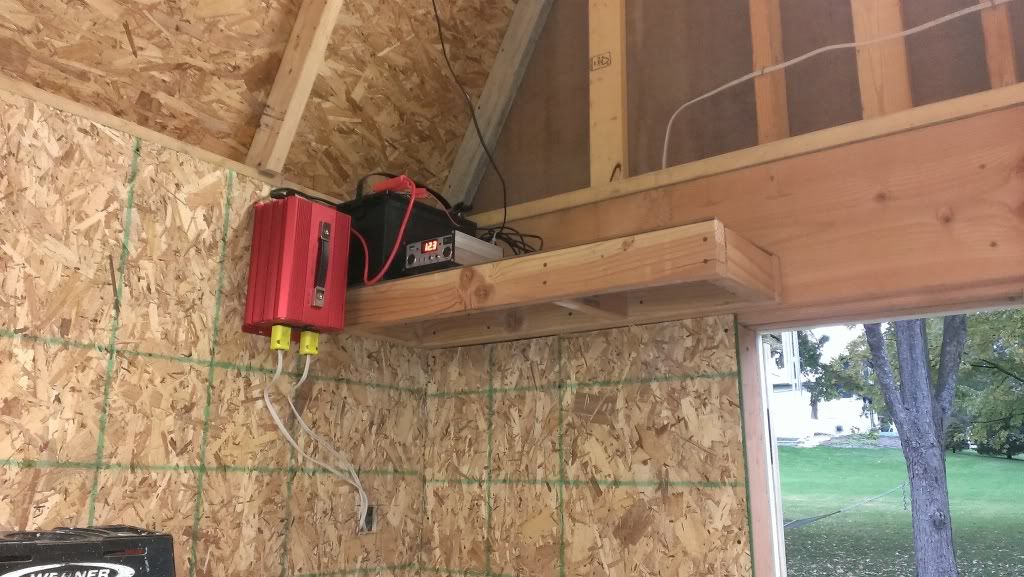
Closeup. Charge controller to be replaced. Borrowing the HF stuff for now. Hey, it works.

Lights on nice and bright. Can't tell a difference from the extension cord...
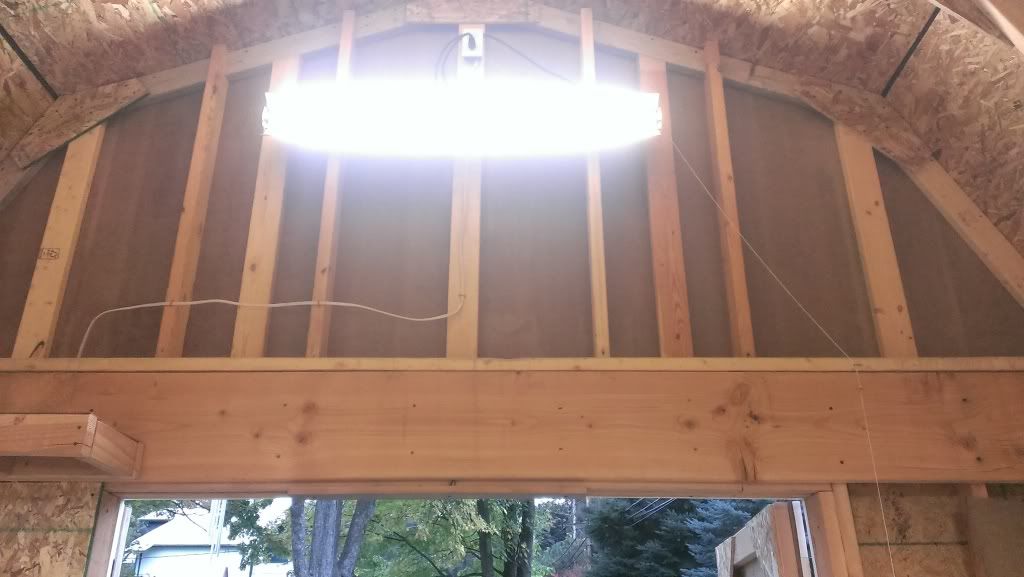
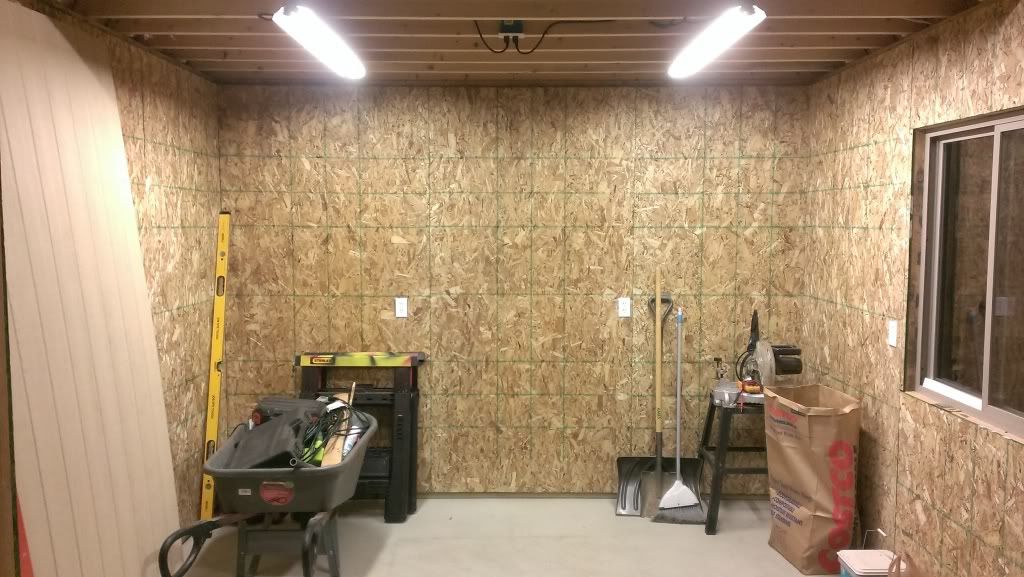
Each wall and the outlets available. More than likely will be used to charge the lithium Ryobi and the DeWalt 18v batteries for the most part...
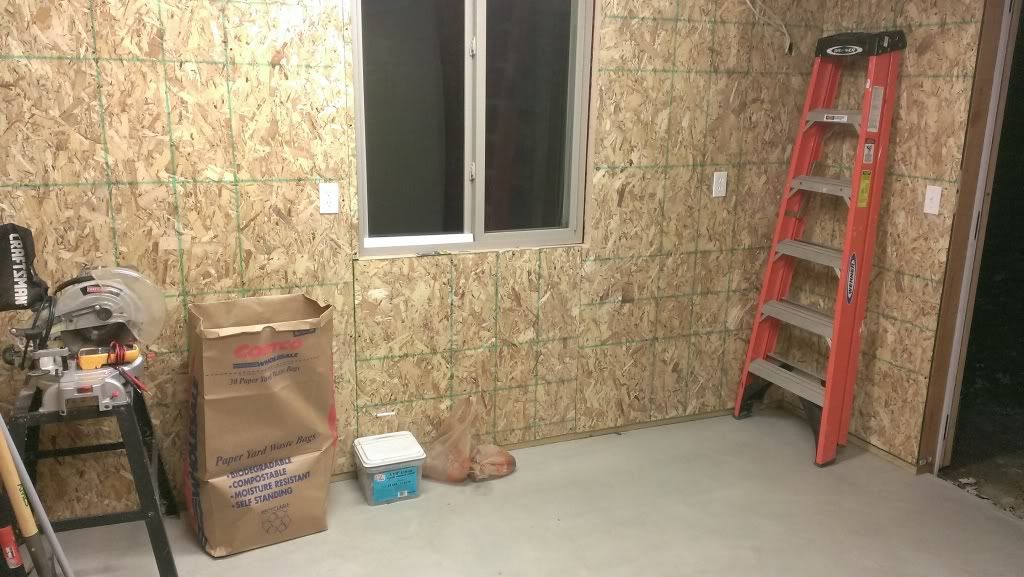
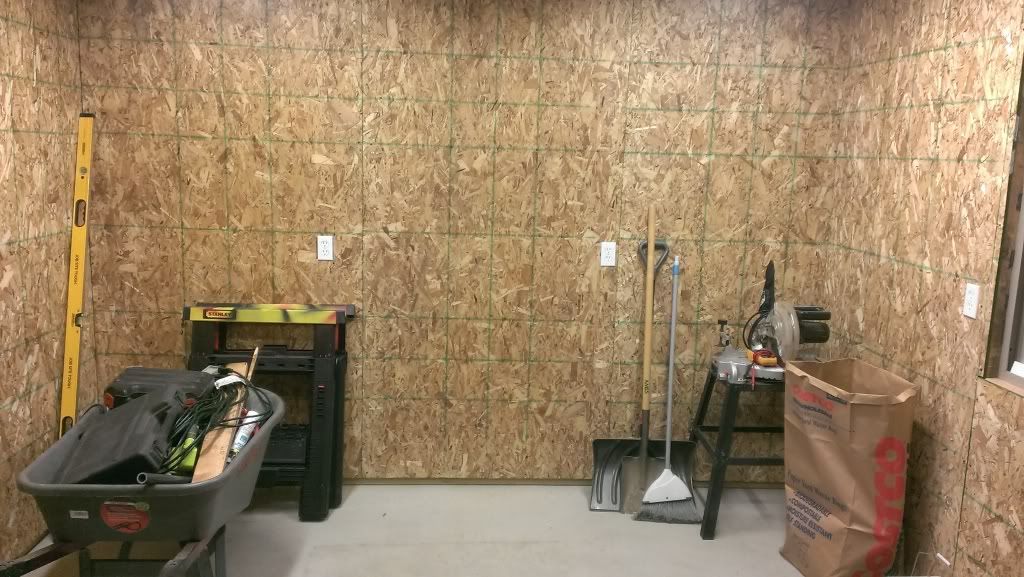

The finished product for the charging setup will include a digital volt/amp meter that I am thinking about wiring in to be able to switch from incoming voltage/amperage to outgoing voltage/amperage so I can see what's coming in and what I'm currently using. Not sure if that will work or if it will blow things up, but I'm going to read up on it. Any thoughts on doing this?
With the current charge controller, we had the 3 lights on for a solid hour at dusk when the panels were hardly charging (though, still seeing voltage) and the controller started out reading 12.9 before turning any lights on. By the time we shut down for the evening, it read 11.9. But as soon as I shut the lights off it jumps to 12.1-12.2. What is this telling me? Anything really without knowing my amperage I was drawing?
Also wondering, will the inverter be alright hanging that way? The cooling fan is pointing up, but I've yet to see/hear it kick on anytime other than start-up for about 3 seconds. This mounting position works well since the inverter switch is within reach of anyone walking in. Open the doors, flip on the inverter, flip the light switch next to the door, and let there be light!
Anyway, that's what I have for now. Comments are welcome. Thanks for the informative posts thus far guys! I'm having a lot of fun with this setup and reading this forum is invaluable.Leave a comment:
-
That's pretty awesome. I think I'll have to get me one of those. Beat's what I already ordered by a mile and only costs $10 more...
Thanks!Leave a comment:
-
Leave a comment:
-
Yeah, I knew I was going to get some heat from some people about the clip on leads. They are temporary. My battery has a threaded post and came with a couple of hex head nuts. It's just a matter of my getting my wire cutters/strippers out and crimping on an eye-hole onto them. Since my charge controller is even more temporary, those clip on leads will be gone and the new controller will have homemade wiring also with eye-hole connectors.
I can't find anything stating exactly if it's pure sine or modified but one of the Amazon reviews is stating that it's modified. I will have to check the paperwork I have on it when I get home. That would be nice if I could get one that recognizes a load so it will flip on automatically. For now, it's a two step process. I might check to see what the inverter pulls when powered on, but with no load.
Fuses on the DC side? There is a fuse on the inverter between the battery connection on the back side (top in the photo). I forget what amp fuse it is...
Regarding the battery being up so high, I don't see it being a big deal to check/add water. I have an 8ft step ladder that gets me right up there. Easy peasy. It's out of the way, and I can't hit my head on the shelf. This shed is 12x12, but it's going to be getting filled up quick and I need to make sure I utilize every inch that I can. As far as it dying sooner due to heat, etc. I'll see how the heat is next spring/summer. Our high temps this week are in the low 50's, and it's not looking up until...March or April? So I'll check on that once we get our temps back.
Edit: Also wanted to add that I was doing some math this morning about my "usage" just going on what we did last night. We ran 3 lights at 64w each for 1 hour. Here is what I came up with:
64w * 3 = 192w
192w / 12v = 16a per hour (correct?)
So, with a 104aH battery, using 16a/h gives a discharge rate of about 6 hours (rounded down). Does this put me at a C6 on the Peukert Law?
The current setup is not recharging at a significant rate to make up this difference so I'm really glad I have the 100w panel coming with an MPPT controller.
Can anyone shed some light on my idea for the digital volt/amp gauge?Leave a comment:
-
As long as the inverter cooling air exhausts uphill (enhancing the chimney effect of hot air rising) it should be OK. (properly designed fans, should be intake fans at the bottom, with cool air flowing over the fan, not like many inverters with exhaust fans on top, all sorts of toasty)
But, I sort of think that clip on leads to the battery are bad.
Having the battery up so high leads to :
a) running warmer and dieing sooner
b) hard to check and add water monthly
c) fuses on the DC side ?
Is the inverter sine wave or modified square ? Most modified waveshape inverters don't work well wired up as "house wire" with a bonded neutral to ground. If you ever get something that bridges the neutral to ground, the magic smoke is released and you get to buy a new inverter.
If you are planning on replacing the inverter anyway, look for a model that can sense an applied load, and automatically turn itself on. It may take 5 seconds to respond to a light switch coming on, they only look for loads at intervals, not continuously.Last edited by Mike90250; 10-20-2013, 11:50 PM.Leave a comment:
-
Well, I thought I would post an update. Finally got the inside finished and the shelf up for the solar equipment inside.
Here it is. One plug for the lights, one for the wall sockets.

Closeup. Charge controller to be replaced. Borrowing the HF stuff for now. Hey, it works.

Lights on nice and bright. Can't tell a difference from the extension cord...


Each wall and the outlets available. More than likely will be used to charge the lithium Ryobi and the DeWalt 18v batteries for the most part...



The finished product for the charging setup will include a digital volt/amp meter that I am thinking about wiring in to be able to switch from incoming voltage/amperage to outgoing voltage/amperage so I can see what's coming in and what I'm currently using. Not sure if that will work or if it will blow things up, but I'm going to read up on it. Any thoughts on doing this?
With the current charge controller, we had the 3 lights on for a solid hour at dusk when the panels were hardly charging (though, still seeing voltage) and the controller started out reading 12.9 before turning any lights on. By the time we shut down for the evening, it read 11.9. But as soon as I shut the lights off it jumps to 12.1-12.2. What is this telling me? Anything really without knowing my amperage I was drawing?
Also wondering, will the inverter be alright hanging that way? The cooling fan is pointing up, but I've yet to see/hear it kick on anytime other than start-up for about 3 seconds. This mounting position works well since the inverter switch is within reach of anyone walking in. Open the doors, flip on the inverter, flip the light switch next to the door, and let there be light!
Anyway, that's what I have for now. Comments are welcome. Thanks for the informative posts thus far guys! I'm having a lot of fun with this setup and reading this forum is invaluable.Leave a comment:
-
You are on-track you are with your thinking - especially since you are taking winter-hours of solar-insolation into account, and not just sunrise-sunset hours.
You may not need more than two days at this point in winter. Ideally, one strives to put back 110 to maybe 120% of what you took out to get a full charge because charging isn't perfectly efficient.I guess I better make sure I give it a few days to charge after a good hard Saturday of use.
For a backup, perhaps just a 10amp AC charger will do considering you are using a 104 ah batttery. That's just about right at C/10 current. The window is C/12 to C/8 for FLA, so you have some wiggle room. Choose wisely as some automotive type chargers will do EQ and other optimization tricks behind your back that you may want to have more control over. Essentially, if they don't publish the voltage specs, or have been verified by another, be cautious.
Yes! However, in summer you will most likely make it with longer solar insolation hours. But most design for winter unless it is just a summer project.So what I am thinking is that if this shed starts getting regular use, I will be needing to purchase another 100w panel to keep my battery from taking a crap on me in 6 months.
So yes, a 200 watt system driving a 104ah battery would do fine as that is in the C/12 to C/8 window, and even in winter, you'll have enough hours to do the job *as it stands now*. Take that 104ah battery down to 50% DOD, with only two hours of winter insolation even at 200 watts, you are back to square one.
The 18v I used was for a standard "battery" panel, and not one that is a higher voltage "GTI" grid tie panel. The typical Open-Circuit-Voltage OCV of a battery panel is anywhere from 17 to 21 volts or so. So it was easy to calculate the BEST, but not real world output considering losses, amperage.
In the solar game, unless you are doing space-orbit calculations, round down. Ie, when we calculate a 100 watt panel being able to turn out 5.555 A, just round down to 5 even to give you some headroom.
Typically a pwm charge controller and less than perfect conditions means that you are looking at 75% rated efficiency of the system as a whole. MPPT can go higher under certain conditions and many threads to explore on that. So now, one also wants to account for inefficiencies.
Basically your choice of another panel would be just fine for a starter setup, the loads you use, the capacity and chemistry of your battery, and the solar-insolation you are facing in the winter. Solar is a LOT more fun when you do the math rather than winging it! Good to see you calculating what you need...Leave a comment:
-
That was a very informative post. THANK YOU for that!
So here is what I ended up with after a trip to Wal Mart:
Everstart Group 27DC Marine Battery(Hybrid, since it still has a CA rating) but it is rated at 104ah as noted on the battery.
I have since ordered my MPPT charge controller, however, for the first couple of weeks I'll be using the Harbor Freight crap until the MPPT arrives along with my new 100w panel.
And to clarify, I have 3 T8 4' Flouescent Lights installed which claim to be 32w each, or 64w for each light. 2 of which are on the same switch, 1 is for shining into the loft area when needed.
So using your math (thanks!) here is what I've come up with. I won't be spending 8 hours out there unless it's a weekend and I am working on something specific. But I'll use 4 hours for my math (even though I think that is overshooting it still)
64w / 12v = 5.333 amps per hour. So, 5.33 * 4 hours = 21.33 amp hours
So with 1 100w panel charging at 18v (how do I come up with 18v if it's a 12v battery/charge controller, etc?) 100w/18v = 5.55amps at 2.5 hours a day in December.
So I'm putting back in 5.55 * 2.5 = 13.875 on average in a day.
I guess I better make sure I give it a few days to charge after a good hard Saturday of use.
I do have a backup plan in case I need to use the lights/plugs for an extended period of time. I can run an extension cord from the house and it plugs into both strings and works at full power so...just in case. lol. I'll make sure I do this in times of serious need.
So what I am thinking is that if this shed starts getting regular use, I will be needing to purchase another 100w panel to keep my battery from taking a crap on me in 6 months.
Then it will be more like 200w/18v = 11.11 amps * 2.5 hours = ~28 amp hours. Effectively doubling my recharging in a days worth of time.
Am I doin that right?
Thanks again for the awesome reply. That math will help me better understand my needs and help me build an overall better setup for my shed and it's (growing) needs for power.Leave a comment:
-
You got it!
Consider you purchasing a dual-purpose battery rated at say 75ah at the industry standard 20-hour rate. (If that can't be found, and only an "RC" value on the battery exists, multiply that RC value by 0.6 to get a ballpark ah rating. It isn't the best battery if you can't find a rate, but moving on.....
You want to hang out in your man-cave-shed from 6p to 2am and want to light it up for 8 hours with a 100 watt incandescent bulb. Let's change that to a 25 watt CFL bulb to save energy, but provides nearly the same amount of illumination. How much will be pulled from the battery?
25w / 12v = 2.083 amps per hour. So, 2.083 * 8 hours = 16.5 amp hours pulled total. Since one doesn't want to deplete a battery by more than 50% DOD on average, that means doubling that capacity, so you would want at least at 35ah battery. AGM's are commonly found in this size.
Cool - but the problem is that in winter, you only have about 2.5 hours of solar insolation (If I remember correctly), and your 100 watt panel at the very best would produce 5.5a charge during bulk (100w / 18v). Let's not get picky and say you are using a quality pwm charge controller.
Well, with only 2.5 hours solar insolation * 5.5a = 11 amp hours. Uh oh - you need to put back at least 16.5ah. Actually a bit more since recharging isn't 100 percent efficient.
Welcome to deficit-charge land, where your battery dies prematurely.
So now you need more panel power, BUT you must keep it within a minimum and maximum boundary rating. For FLA batteries, that is usually between C/12 and C/8. For a 75ah FLA battery, that means you need to supply between 6.25A minimum, and 9.375A maximum. AGM's are about twice this, unless they are specialty types.
So now that you know your loads, you size your battery properly to avoid going below 50% DOD during your usage timeframe, and size the panels accordingly so as not to tickle the batteries to death, nor harm them with overcharge. AND, we're only talking about a system with NO extra days of bad-weather autonomy!
Account for some bad-weather autonomy days, and your jaw will drop when you see what it takes $$ to merely light up the man cave 8 hours daily with a 25 watt bulb.Leave a comment:
-
Leave a comment:
-
Don't worry - we all do at first, so you'll be joining the club sooner or later.
If you want to start out on the right foot, read the stickes and faqs right here on the site! It will save you money and time. As of right now, I'd stop thinking of buying anything more than just a *single* battery for your initial system. One of the things you'll find out is that you don't want to use a car-battery, which is called an "SLI" or starter/lights/ignition battery that is not designed for deep cycling.
The only reason I keep saying that I'll get 2 batteries is because I'd like to have a good reserve bank of energy. Is this system going to struggle to keep both batteries topped off?
Also, I completely understand about the SLI batteries. The ones I'll be purchasing will definitely not be regular old car batteries. I just happened to have an old battery in my garage that has been sitting for a year and I don't even honestly know if it's any good. That being said, I am going to hook that up this evening (got carried away watching the Tigers last night and lost time) and just see if it will even power my shop lights. Then I'll probably head to Wal Mart and grab a deep cycle battery and try using my old one as a core...
Thanks for the tips! I've been bouncing around since I signed up reading the stickied posts and FAQ stuff. Lots of good info around here. I'm lovin' it.Leave a comment:
-
Don't worry - we all do at first, so you'll be joining the club sooner or later.
If you want to start out on the right foot, read the stickes and faqs right here on the site! It will save you money and time. As of right now, I'd stop thinking of buying anything more than just a *single* battery for your initial system. One of the things you'll find out is that you don't want to use a car-battery, which is called an "SLI" or starter/lights/ignition battery that is not designed for deep cycling.Leave a comment:
Copyright © 2014 SolarReviews All rights reserved.
Powered by vBulletin® Version 6.1.0
Copyright © 2025 MH Sub I, LLC dba vBulletin. All rights reserved.
Copyright © 2025 MH Sub I, LLC dba vBulletin. All rights reserved.
All times are GMT-5. This page was generated at 12:45 AM.

Leave a comment: